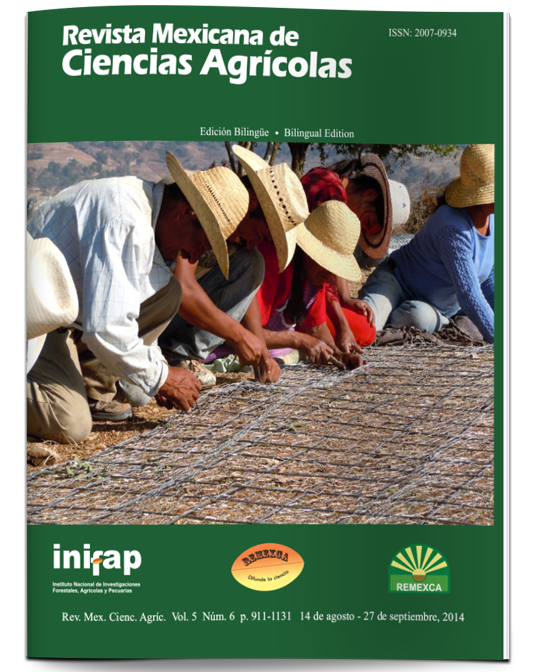Defoliation effect on yield in corn-bean intercropping
DOI:
https://doi.org/10.29312/remexca.v5i6.886Keywords:
Phaseolus vulgaris L., Zea mays L., biomass, phenologyAbstract
Yield of both corn and beans in monoculture is determined by the genotype and the environment. However, the intercropping of these crops can increase production per unit area. None the less, the effect of interspecific competition where beans is the most affected and it is assumed that corn shading on bean has not been addressed properly. The objective of the study was to determine the effect of defoliation on corn on total biomass (BT), harvest index (IC), yield (RG) and intercropping components of beans and corn. The experiment was conducted in Montecillo, Mexico, during the spring-summer cycles of 2010 and 2011, with an experimental design of complete randomized block with four replications. On the occurrence of phenological stages in beans and corn, was similar between treatments. BT and IC, thus RG and intercropping components in beans and corn showed significant changes by effect of the year, defoliation and interaction year*defoliation. On beans the highest RG was observed in 2010, which exceeded 36% to 2011. In both years with the defoliation of the upper layer (DES) were achieved the highest RG and the lowest RG corresponded to the treatment without defoliation (SD).
Downloads
Downloads
Published
How to Cite
Issue
Section
License
The authors who publish in Revista Mexicana de Ciencias Agrícolas accept the following conditions:
In accordance with copyright laws, Revista Mexicana de Ciencias Agrícolas recognizes and respects the authors’ moral right and ownership of property rights which will be transferred to the journal for dissemination in open access. Invariably, all the authors have to sign a letter of transfer of property rights and of originality of the article to Instituto Nacional de Investigaciones Forestales, Agrícolas y Pecuarias (INIFAP) [National Institute of Forestry, Agricultural and Livestock Research]. The author(s) must pay a fee for the reception of articles before proceeding to editorial review.
All the texts published by Revista Mexicana de Ciencias Agrícolas —with no exception— are distributed under a Creative Commons License Attribution-NonCommercial 4.0 International (CC BY-NC 4.0), which allows third parties to use the publication as long as the work’s authorship and its first publication in this journal are mentioned.
The author(s) can enter into independent and additional contractual agreements for the nonexclusive distribution of the version of the article published in Revista Mexicana de Ciencias Agrícolas (for example include it into an institutional repository or publish it in a book) as long as it is clearly and explicitly indicated that the work was published for the first time in Revista Mexicana de Ciencias Agrícolas.
For all the above, the authors shall send the Letter-transfer of Property Rights for the first publication duly filled in and signed by the author(s). This form must be sent as a PDF file to: revista_atm@yahoo.com.mx; cienciasagricola@inifap.gob.mx; remexca2017@gmail.
This work is licensed under a Creative Commons Attribution-Noncommercial 4.0 International license.



